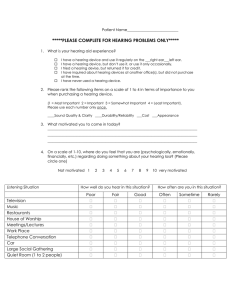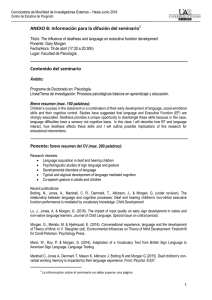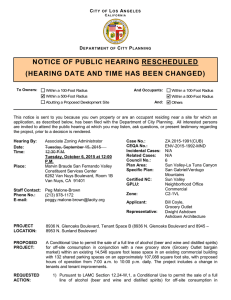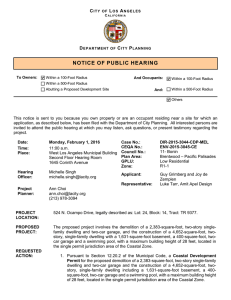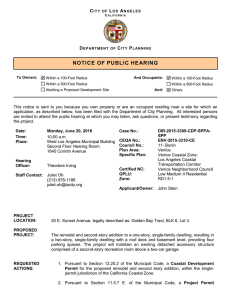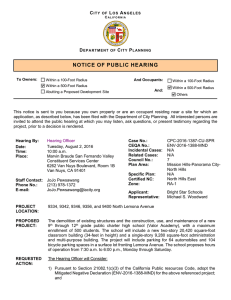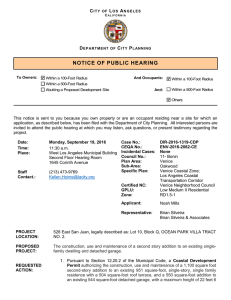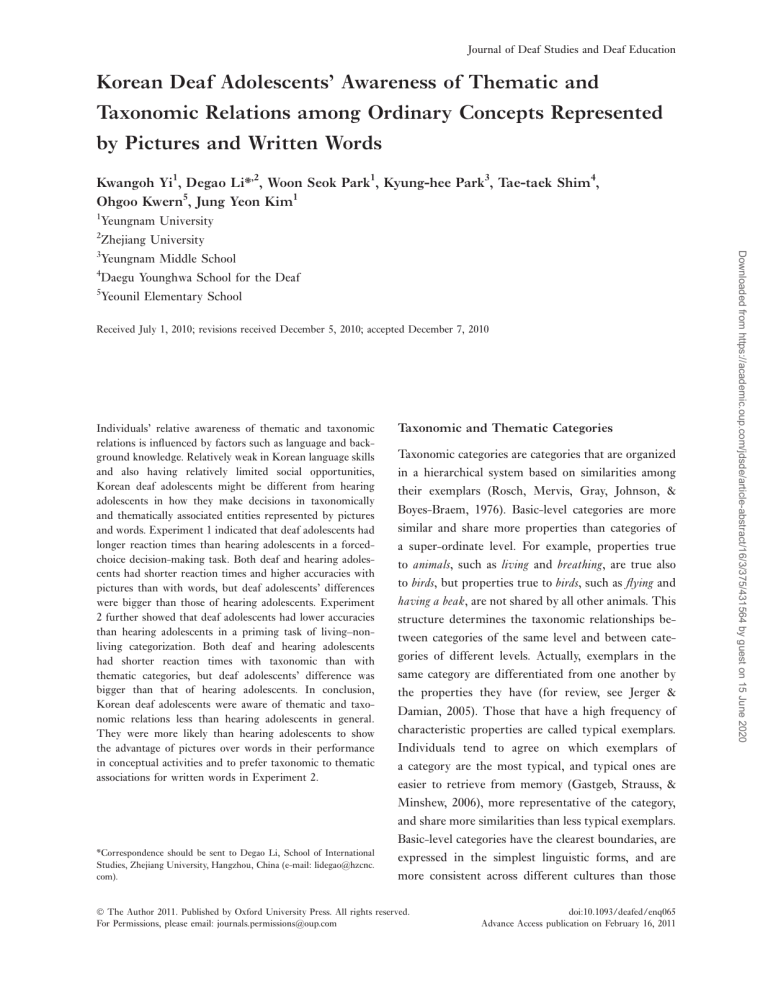
Journal of Deaf Studies and Deaf Education Korean Deaf Adolescents’ Awareness of Thematic and Taxonomic Relations among Ordinary Concepts Represented by Pictures and Written Words Kwangoh Yi1, Degao Li*,2, Woon Seok Park1, Kyung-hee Park3, Tae-taek Shim4, Ohgoo Kwern5, Jung Yeon Kim1 Yeungnam University 2 Zhejiang University Yeungnam Middle School 3 4 5 Daegu Younghwa School for the Deaf Yeounil Elementary School Received July 1, 2010; revisions received December 5, 2010; accepted December 7, 2010 Individuals’ relative awareness of thematic and taxonomic relations is influenced by factors such as language and background knowledge. Relatively weak in Korean language skills and also having relatively limited social opportunities, Korean deaf adolescents might be different from hearing adolescents in how they make decisions in taxonomically and thematically associated entities represented by pictures and words. Experiment 1 indicated that deaf adolescents had longer reaction times than hearing adolescents in a forcedchoice decision-making task. Both deaf and hearing adolescents had shorter reaction times and higher accuracies with pictures than with words, but deaf adolescents’ differences were bigger than those of hearing adolescents. Experiment 2 further showed that deaf adolescents had lower accuracies than hearing adolescents in a priming task of living–nonliving categorization. Both deaf and hearing adolescents had shorter reaction times with taxonomic than with thematic categories, but deaf adolescents’ difference was bigger than that of hearing adolescents. In conclusion, Korean deaf adolescents were aware of thematic and taxonomic relations less than hearing adolescents in general. They were more likely than hearing adolescents to show the advantage of pictures over words in their performance in conceptual activities and to prefer taxonomic to thematic associations for written words in Experiment 2. *Correspondence should be sent to Degao Li, School of International Studies, Zhejiang University, Hangzhou, China (e-mail: lidegao@hzcnc. com). Taxonomic and Thematic Categories Taxonomic categories are categories that are organized in a hierarchical system based on similarities among their exemplars (Rosch, Mervis, Gray, Johnson, & Boyes-Braem, 1976). Basic-level categories are more similar and share more properties than categories of a super-ordinate level. For example, properties true to animals, such as living and breathing, are true also to birds, but properties true to birds, such as flying and having a beak, are not shared by all other animals. This structure determines the taxonomic relationships between categories of the same level and between categories of different levels. Actually, exemplars in the same category are differentiated from one another by the properties they have (for review, see Jerger & Damian, 2005). Those that have a high frequency of characteristic properties are called typical exemplars. Individuals tend to agree on which exemplars of a category are the most typical, and typical ones are easier to retrieve from memory (Gastgeb, Strauss, & Minshew, 2006), more representative of the category, and share more similarities than less typical exemplars. Basic-level categories have the clearest boundaries, are expressed in the simplest linguistic forms, and are more consistent across different cultures than those Ó The Author 2011. Published by Oxford University Press. All rights reserved. For Permissions, please email: [email protected] doi:10.1093/deafed/enq065 Advance Access publication on February 16, 2011 Downloaded from https://academic.oup.com/jdsde/article-abstract/16/3/375/431564 by guest on 15 June 2020 1 376 Journal of Deaf Studies and Deaf Education 16:3 Summer 2011 were biased toward the thematic association because their knowledge of the world was mainly based on life experiences (Scheuner, Bonthoux, Cannard, & Blaye, 2004). In another study, also elderly people tended to prefer thematic to taxonomic relations in categorization tasks in comparison with young adults because autobiographical experiences constrain the perception of commonalities, and conceptual preferences are modified as a result (Pennequin et al., 2006). Deaf individuals can be different from hearing individuals in many ways. For example, living in the same cultural environment as hearing individuals, deaf individuals born to hearing parents are likely to be at the risk of having fewer language experiences and/ or receiving less education than their hearing peers (Marschark, Lang, & Albertini, 2002). Thus, one might wonder whether deaf individuals can be different from hearing individuals in their relative awareness of taxonomic and thematic associations among ordinary entities. Deaf Individuals’ Conceptual Organizations Young deaf children do not seem to be different from young hearing children in their conceptual development in general. For example, Blank and Bridger (1966) tested 3- and 5-year-old hearing and deaf children on problems involving the concepts of something versus nothing (e.g., light vs. no light) to compare their ability to transfer a concept across sensory modalities. The results showed that the 3-year-old deaf and hearing children performed equally poorly and that the 5-year-old deaf and hearing children performed equally well, indicating that young deaf and hearing children are equally able to have their concepts developed. Motivated by the fact that deaf students lag behind hearing students at mathematics, studies were conducted into deaf children’s representations of numbers. For example, 3- and 4-year-old deaf and hearing children had the same ability to remember and to reproduce the number of items in sets of objects, suggesting that preschool deaf children’s number representation is as advanced as that of hearing children (Zarfaty, Nunes, & Bryant, 2004). Utterances expressing generic kinds (e.g., birds fly and wheels go around) refer to categories of objects Downloaded from https://academic.oup.com/jdsde/article-abstract/16/3/375/431564 by guest on 15 June 2020 of other levels. The taxonomic relationships between basic-level categories of high typicality are stronger than between those of low typicality. Thematically associated items can also be taken as categories, whose exemplars are associated by external relations, such as part-whole (e.g., a roof is on top of a house), functional (e.g., a piece of chalk is used to write on a blackboard), causal (e.g., electricity makes a light bulb glow), and temporal (e.g., bills typically come after meals in restaurants) relations among objects, events, people, and other entities that interact (Lin & Murphy, 2001). Mandler (1977, p. 263) took thematic categories as ‘‘parts that are connected on the basis of contiguities that have been experienced in space or time.’’ In a thematic category, the exemplars have different but complementary roles in the same scene or event. Thematic associations emphasize events rather than taxonomic similarities (Markman & Hutchinson, 1984). The development of taxonomic knowledge can be effectively fostered by communication and education (Vygotsky, 1999), but knowledge of thematic associations is mainly based on life experiences. For instance, the word rain can be expected to activate more concepts for Londoners than for Tibetans. A toddler may put a toy car and a toy person together and say, ‘‘A person drives a car.’’ For Koreans ‘‘horse’’ is closely associated with ‘‘carrot’’ because a horse eats a carrot in a traditional Korean story, which almost every Korean has heard hundreds of times since he or she was young. Thematically associated items can be characterized by the familiarity of the items and by the strength of associations between them (e.g., Pennequin, Fontaine, Bonthoux, Scheuner, & Blaye, 2006). Thematic and taxonomic relations coexist in the conceptual organizations of human beings (Blaye & Bonthoux, 2001; Blewitt & Toppino, 1991; Borghi & Caramelli, 2003; Lin & Murphy, 2001; Markman & Hutchinson, 1984). Because of the influences of factors such as language and background knowledge, whether taxonomic relations are relatively more salient than thematic associations or vice versa can be different for different people. Suppose Picture A was thematically related to Picture B and taxonomically related to Picture C. When choosing which of B and C went well with A, 4- and 6-year-old hearing children Korean Deaf Adolescents’ Awareness of Thematic and Taxonomic Relations 377 that college deaf and hearing students were similar in their overall organization of lexical knowledge, but hearing students had stronger associations than deaf students between category names and exemplar words (Marschark, Convertino, McEvoy, & Masteller, 2004). In addition, college deaf students had relatively stronger associations from words for taxonomic categories of basic level (e.g., snake) to those of super-ordinate level (e.g., reptiles) than vice versa, in comparison with hearing students. Li and Zhang (2009) required deaf and hearing adolescents to memorize concrete words and pictures for exemplars of taxonomic, thematic, and slot-filler (Lucariello & Nelson, 1985) categories and then recall and write on pieces of paper as many words for the categories as possible. Slot-filler categories (e.g., lunch foods) are categories that are based on events (e.g., eaten at lunch), the actions of which are complemented by concrete things (e.g., steamed bread, rice or salted fish). The results showed the deaf adolescents had lower ratios of correct recall of stimuli than the hearing adolescents. The deaf adolescents seemed aware of relationships between entities less than the hearing adolescents in the memory task. In another study, deaf adolescents performed two tasks: (a) deciding whether four sequentially presented basic-level exemplars were of the same taxonomic category and (b) studying some words for basic-level exemplars and then recognizing both the studied and some nonstudied words for exemplars of the same categories (Zhang, Li, & Wu, 2008). The deaf adolescents’ performance was poorer with exemplars of low typicality than with those of high typicality. They were certain about which categories the taxonomic exemplars of high typicality belong to but seemed less certain with those of low typicality, in comparison with the hearing adolescents. To examine the quality of the semantic categorization of deaf children (age range: 8.6–12.4 years), Ormel et al. (2010) used basic-level exemplars as stimuli and conducted a forced-choice task: The participants had to select one item (e.g., mosquito) that best matched the target (e.g., bees) from the four simultaneously presented items in a trial. The deaf children tended to have a lower accuracy than their hearing counterparts, and the authors concluded that the semantic–categorical knowledge of deaf children Downloaded from https://academic.oup.com/jdsde/article-abstract/16/3/375/431564 by guest on 15 June 2020 (birds and wheels as classes of objects). Birds fly implies a property that applies to birds in general. Goldin-Meadow, Gelman, and Mylander (2005) observed that young deaf children from America and China, who were born to hearing parents and not exposed to a conventional sign language, used generics in the home signs they invented to express generic kinds. For example, the deaf American children first pointed at a picture of an unmoving pinwheel, then at an unconnected wheel, and made a go-around gesture to express wheels go around. The researchers found that the young deaf American and Chinese children produced generic utterances at about the same rate as the hearing children growing up in the same cultures, suggesting that young deaf children are similar to hearing children in their categorical knowledge. Similarly, second-generation deaf children seemed to have the same pattern of relative awareness of thematic and taxonomic relations as hearing children of the same age (Courtin, 1997). To examine how sign language affected 6-year-old deaf children’s categorization of ordinary entities, Courtin required deaf and hearing children to select thematic or taxonomic alternatives as associations to the target in a trial: Either choosing one from a pair of items that were thematically associated with the target or one from a pair of items that were taxonomically related to the target. The materials were presented in two conditions: linguistic condition in which the three taxonomically related items shared a generic sign in sign language and control condition in which the three taxonomically related items did not share a common generic sign. The deaf children, who were native sign language users, were more likely than the hearing children to prefer taxonomic to thematic relations under the linguistic condition. When the influence of sign language was eliminated under the control condition, however, they were not different from the hearing children in their performance of selection. Like the hearing children, the deaf children preferred thematic to taxonomic choices. Deaf adults and adolescents, however, seem different from hearing adults and adolescents, respectively, in experimental performance. For example, the primary responses in a word association task revealed 378 Journal of Deaf Studies and Deaf Education 16:3 Summer 2011 Hypothesis Conceptual organizations are usually investigated with written words as stimuli, but deaf individuals are generally weaker at written languages than hearing individuals. For example, elementary school (Monreal & Hernández, 2005), high school (Kyle & Harris, 2006), and college (Gaustad, Kelly, Payne, & Lylak, 2002) deaf students’ reading development can be seriously delayed. Deaf individuals’ age of acquisition of vocabulary was later than that of hearing individuals (Auer & Bernstein, 2008). The result of a vocabulary test to 10-, 11-, and 12-year-old deaf children showed that they found it extremely difficult to master the second meaning of a multimeaning word (Paul, 1987). The ability of preschool deaf children to learn novel words from context was weaker than that of hearing children of the same age (Lederberg & Spencer, 2009). High school deaf students’ literate proficiency usually cannot surpass that of elementary school hearing students of Grade 4 (Harris & Moreno, 2004). How to recognize written words is a learned skill that is developed several years later than how to recognize pictures. The efficiency to recognize words can be relatively lower than to recognize pictures as indicated by the sensory–semantic theory (Nelson, Reed, & McEvoy, 1977). The sensory–semantic theory assumes that pictures hold two encoding advantages over words: Pictures are perceptually more distinct from one another than are words and are encoded more uniquely to increase their chances for retrieval. Pictures access meaning more directly than words. Because conceptual processing makes a stronger contribution than perceptual processing to the advantage of pictures over words in recognition (Stenberg, 2006), people might be able to perform better with pictures than with words on tasks in which relations among stimuli were the focus of investigation. One could deduce that deaf individuals would perform worse with words than with pictures for ordinary concepts. This deduction seemed to be confirmed by Ormel et al. (2010). Ormel et al. used written words and colored line drawings as the stimuli and found that the hearing children outperformed the deaf children for words but relatively less so for pictures. Although the hearing children’s performance was not significantly different with pictures than with words, the deaf children performed better with pictures than with words. Obviously, a more complete image of deaf individuals’ awareness of thematic and taxonomic relations might be revealed if pictures for ordinary entities were used as well as words rather than if only words were used as stimuli. Therefore, a task of forcedchoice decision making and a priming task of living– nonliving categorization were conducted to test the following hypothesis on Korean deaf adolescents in the present study: If Korean deaf adolescents had developed a different pattern of awareness of taxonomic and thematic associations in comparison with hearing adolescents, then they would be different from hearing adolescents in reaction times and accuracies when making decisions on taxonomic and thematic associations among ordinary entities represented by pictures and written words. Experiment 1 In a task of forced-choice decision making, participants have to compare the two relations among three simultaneously presented items A, B, and C: A is thematically associated with B and taxonomically related to C in a trial, and a decision has to be made as to whether B goes better with A than C or C goes better with A than B. Lin and Murphy (2001) came to a conclusion with this task that hearing adults have similar Downloaded from https://academic.oup.com/jdsde/article-abstract/16/3/375/431564 by guest on 15 June 2020 appears less precise or less finely differentiated than that of hearing children. Children’s attention to taxonomic relations changes with development (Markman & Hutchinson, 1984). Some of the taxonomic knowledge of hearing preschoolers may remain to be developed (for review, see Lucariello, Kyratzis, & Nelson, 1992), but 10-yearold hearing children can theoretically have welldeveloped conceptual organizations (Desprels-Fraysse & Lecacheur, 1996). Young deaf children can be similar to young hearing children in their conceptual organizations, but deaf adolescents and adults may perform differently from hearing adolescents and adults in conceptual activities, respectively. It might be possible, therefore, that deaf adolescents were aware of thematic and taxonomic relations in a different way than hearing adolescents. Korean Deaf Adolescents’ Awareness of Thematic and Taxonomic Relations 379 strengths of thematic and taxonomic relations in their conceptual organizations. Methods Participants. The students and their teachers from two schools for the deaf in Korea responded to a questionnaire, and eight deaf adolescents (five males, M 5 13.0 years, age range: 12.0–14.0 years) were selected as participants. Five of them had a hearing loss of over 90 dB and three over 70 dB on the better ear. Two of the participants received a poor level of language intervention before going to elementary schools, but the others had received a good level of language intervention. One of them had a cochlear implant, and five of them often had their hearing aids on. One deaf adolescent had one deaf parent and one had two deaf parents. According to their teachers’ responses, six of them were able to produce understandable oral expressions in everyday communications and two of them had achieved a reading ability that paralleled that of hearing students of the same age. They also received a modified version of Raven Standard Progressive Matrices Test (RSPMT; Zhang & Wang, 1985) and had a direct score of 74.5%. Materials. As the result of a series of evaluations, 24 triads of words were selected, with 2 words (A and C) for 2 exemplars of high typicality from a taxonomic category and 1 word (B) thematically associated with A in a triad, to make 24 thematic–taxonomic sets (see Appendix A). Twenty-four triads of words were selected, with 2 words (A and B) thematically associated and 1 word (C) not conceptually related to A in a triad, to make 24 thematic sets. Twenty-four triads of words were selected, with 2 words (A and C) for 2 exemplars of high typicality from a taxonomic category and 1 word (B) not conceptually related to A in a triad, to make 24 taxonomic sets. The familiarity of all the items, the typicality of the taxonomically related items (As and Cs of the taxonomic and thematic–taxonomic sets), and the association strength between the thematically associated items (As and Bs of the thematic and thematic–taxonomic sets) each were evaluated on a 7point scale by 25 college students (see Table 1). Half of the thematic, taxonomic, and thematic– taxonomic sets would be presented as pictures, respectively. The other half of the thematic, taxonomic, and thematic–taxonomic sets would be presented as words, respectively. Because it was inevitable that an item in some sets was difficult to depict, a rule was accepted according to which a set would be presented as words if at least one of the three items was not easy to depict. For example, ‘‘TV’’ and ‘‘elephant’’ are easy but ‘‘the spring festival’’ and ‘‘trip’’ are difficult to depict. The pictures were not significantly different from the words in typicality for the taxonomically related exemplars, t(94) 5.644, p 5 .521, in association strength for the thematically associated exemplars, t(46) 5 .348, p 5 .731, or in familiarity, t(166) 5 .631, p 5 .512, for all the items. An evaluation test of picture–word consistency was done on a 7-point scale by another 25 college students. The students each were provided with a list of words on a piece of paper. Numbers one to seven were marked on the right-hand side of each word. For each picture shown on the screen in front of them with Downloaded from https://academic.oup.com/jdsde/article-abstract/16/3/375/431564 by guest on 15 June 2020 The design formed a 2 3 2 3 3 (Hearing status [hearing, deaf] 3 Presentation mode [picture, word] 3 Category set [thematic, taxonomic, and thematic– taxonomic]) complex factorial with hearing status as between-participants variables and presentation mode and category set within-participants variables. The dependent variables were reaction times and accuracies. The three levels of category set were thematic (A was thematically associated with B but had no conceptual relation with C), taxonomic (A was taxonomically related to C but had no conceptual relation with B), and thematic–taxonomic (A was thematically associated with B and taxonomically related to C) set. For a thematic or taxonomic set, a strong conceptual relation would be compared with a relation of null strength (A was not conceptually related to B for a taxonomic set, or A was not conceptually related to C for a thematic set). Deaf adolescents would have a poorer performance than hearing adolescents for the thematic and taxonomic sets if they were aware of conceptual relations less in general. Similarly, 11 hearing adolescents (six males, M 5 13.0 years, age range: 12.0–14.0 years) with a direct RSPMT score of 74.8% were recruited at random from an elementary school. 380 Journal of Deaf Studies and Deaf Education 16:3 Summer 2011 Table 1 Characteristics of items of the thematic (Experiment 1 and Experiment 2), the taxonomic (Experiment 1 and Experiment 2), and the thematic–taxonomic (Experiment 1) sets Experiment 1 Item Word lengtha (M 6 SD) Thematic A B C A B C A B C Prime Target Prime Target 1.96 1.95 2.03 2.33 2.25 2.25 2.07 2.02 2.25 1.98 1.94 2.24 2.26 Taxonomic Thematic–taxonomic Experiment 2 Thematic Taxonomic 6 6 6 6 6 6 6 6 6 6 6 6 6 0.59 0.65 0.62 0.49 0.45 0.63 0.39 0.49 0.87 0.44 0.50 0.62 0.68 Familiarity (M 6 SD) 5.26 5.25 5.52 5.28 5.34 5.22 5.33 5.38 5.33 5.33 5.52 5.50 5.43 6 6 6 6 6 6 6 6 6 6 6 6 6 1.09 1.14 1.04 1.20 1.16 1.14 1.19 1.18 1.16 1.28 1.21 1.13 1.15 TP/ASb (M 6 SD) 6.30 6 0.24b — 6.44 6 0.48 — 6.26 6 0.73 6.17 6 0.80 6.27 6 0.19** 6.28 6 0.93 6.32 6 0.27** 6.36 6 0.65 6.27 6 0.59 a The Korean alphabet, Hangul, maps letters onto phonemes, and Hangul letters are printed in syllable blocks (SBs). The overall shape of a Korean word appears similar to a Chinese word. For example, the word for cola is . Most Korean words for ordinary concepts are composed of two or three SBs, but many words that are of the highest familiarity are of one SB. Word length refers to the number of SB and was only calculated for the stimuli presented as written words. b TP/AS means typicality or association strength. The values in this column marked with ‘‘**’’ were evaluation scores of association strength between As and Bs in Experiment 1 or between primes and targets in Experiment 2. The values not marked with ‘‘**’’ were evaluation scores of typicality. an overhead projector in a classroom, they must tick one number beside the word to indicate how much it represented the corresponding thing. The bigger the number was the more the picture represented the thing. The average score of evaluation of picture–word consistency was 6.36 6 0.24 (M 6 SD). All the pictures were made of 240 3 240 pixels. For example, Figure 1 displays two triads of pictures (monkey, banana, and elephant for one triad, and recorder, tape, and radio for another). Procedure. SuperLab 4.0 was used to control the experiment on personal computers (HP Compaq nx6330). The screen resolution was 1280 3 800 pixels. For each trial, a red fixation cross ‘‘1’’ remained at the white screen centre for 800 ms. Then three items, A, B, and C, were presented simultaneously to make a triangular contour with A the apex and B and C the two base angles, respectively (see one triad of pictures in Figure 1). Words were presented in Song-36. The distance between B and C was 360 pixels, and A was 280 pixels vertically above B. Whether B was the base angle on the left- or right-hand side was determined randomly. The three items stayed on the screen for 3000 ms or until a key press was received. The intertrial interval was 1000 ms. Explanations were delivered to hearing adolescents in oral language and to deaf adolescents in sign language. Participants were Figure 1 Two triads of pictures in each of which participants had to decide whether the top picture was conceptually related to the bottom left picture more than it was to the right one. Downloaded from https://academic.oup.com/jdsde/article-abstract/16/3/375/431564 by guest on 15 June 2020 Category set Korean Deaf Adolescents’ Awareness of Thematic and Taxonomic Relations 381 Results The data for the trials in which the participants’ reaction times were below 200 ms or 3 SD above the average were discarded. Totally 2.6% of the data were excluded. Accuracies. For a thematic–taxonomic set, some participants decided that the taxonomic relation was stronger than the thematic association but others decided that the thematic association was stronger than the taxonomic relation. The frequencies with which the hearing and the deaf participants preferred taxonomic to thematic associations when stimuli were pictures and words were illustrated in Figure 2. A chi- Figure 2 Frequencies of decision that 8 deaf and 11 hearing adolescents preferred taxonomic to thematic associations for the 12 thematic–taxonomic sets presented as pictures and words. square test of the frequencies indicated that the hearing and the deaf participants seemed to have the same tendency: They tended to prefer taxonomic to thematic associations among pictures more than among words, v2 (1, N 5 243) 5 3.000, p 5 .083. Data for the thematic and the taxonomic sets were analyzed separately from those for the thematic– taxonomic sets. A 2 3 2 3 2 (Hearing status 3 Presentation mode 3 Category set [thematic, taxonomic]) analysis of variance (ANOVA) of mixed measures to the accuracy data showed that the main effect was significant for presentation mode, F1(1, 18) 5 19.51, p 5 .000, g2 5 .534. The deaf and the hearing participants’ accuracies were significantly higher for pictures (M 5 0.973, SE 5 0.012; M 5 0.977, SE 5 0.010) than for words (M 5 0.849, SE 5 0.034; M 5 0.932, SE 5 0.029), respectively. The other effects were not significant. Because the number of the deaf participants was relatively small, a 2 3 2 3 2 (Hearing status 3 Presentation mode 3 Category set [thematic, taxonomic]) ANOVA of mixed measures to the accuracy data was also done by item. Hearing status was the within-items variables and presentation mode and category set the between-items variables. Similar results were obtained: The main effect was significant for presentation mode, F2(1, 44) 5 9.39, p 5 .004, g2 5 .176). The other effects were not significant. Reaction times. Reaction times were calculated for the correct responses only. For the thematic–taxonomic sets, all the responses were taken as correct. A 2 3 2 3 3 (Hearing status 3 Presentation mode 3 Category set) Downloaded from https://academic.oup.com/jdsde/article-abstract/16/3/375/431564 by guest on 15 June 2020 also shown with demonstrations of how to make a decision by pressing the key ‘‘Z’’ or ‘‘/’’ (‘‘/’’ was horizontally separated from ‘‘Z’’ by eight keys). The experiment was conducted in groups of three to six deaf or hearing participants. Each participant was led by an assistant (a graduate student in psychology) to one of the desks, which were separated from one another by a distance of at least 2 m in a large quiet room. Once seated, a participant was indicated to turn on the laptop on his/her desk and get familiar with the computer. Each of the assistants was in charge of making one participant busy on his or her computer before the experimenter (the second author) came up to deliver the instruction. There will be three words or three pictures on the screen. The three items form a contour of triangle. Please decide whether the top word/picture is conceptually related to the bottom left word/picture more than it is to the right one. If so, press the key ‘‘Z’’ with the forefinger of the left hand. Otherwise, press the key ‘‘/’’ with the forefinger of the right hand. Explanations and demonstrations were shown to one student after another. Only when the experimenter (a teacher from the school for deaf participants) thought that the student understood the requirements and saw that he/she successively made correct responses for 5 of the 12 practice trials could the instruction delivery begin to the next student. The practice trials were followed by 72 experimental trials. The practice trials were randomized for each student and so were the experimental trials. 382 Journal of Deaf Studies and Deaf Education 16:3 Summer 2011 203 ms) than with pictures (282 6 126 ms), t(70) 5 3.434, p 5 .001. The other effects were not significant. Experiment 2 ANOVA of mixed measures to the reaction times showed that the main effects were significant for presentation mode, F1(1, 34) 5 32.70, p 5 .000, g2 5 .658, and hearing status, F1(1, 34) 5 10.26, p 5 .005, g2 5 .376. The participants’ reaction times were significantly longer when the stimuli were words (M 5 1325 ms, SE 5 59 ms) than when they were pictures (M 5 1158 ms, SE 5 51 ms). The deaf participants’ reaction times (M 5 1411 ms, SE 5 81 ms) were significantly longer than those of the hearing participants (M 5 1072 ms, SE 5 69 ms). The difference of reaction times for the deaf participants was 237 6 115 ms when the stimuli were changed from pictures into words, whereas it was 97 6 133 ms for the hearing participants. The other effects were not significant. Similar results were obtained with the analysis by item. The main effects were significant for presentation mode, F2(1, 66) 5 14.41, p 5 .000, g2 5 .179, and for hearing status, F2(1, 66) 5 315.83, p 5 .000, g2 5 .827. The two-way interaction between presentation mode and hearing status (see Figure 3) was significant, F2(1, 66) 5 12.05, p 5 .001, g2 5 .154. Simple analysis indicated that both the deaf, t(70) 5 4.766, p 5 .000, and the hearing, t(70) 5 2.038, p 5 .046, participants had significantly longer reaction times for words than for pictures, but the deaf participants’ reaction times were significantly longer than those of the hearing ones for picturepresented stimuli, t(35) 5 13.434, p 5 .000, and word-presented stimuli, t(35) 5 12.361, p 5 .000, respectively. Furthermore, the differences between the deaf and the hearing participants in their reaction times were significantly bigger with words (418 6 Methods The design was the same as that of Experiment 1 except that category set had two levels: thematic (primes were thematically associated with targets) and taxonomic (primes were taxonomically related to targets) set. No thematic–taxonomic sets were used in Experiment 2. Participants. Nine deaf adolescents (two males, M 5 15.0 years, age range: 14.0–16.0 years) were selected in the same way as in Experiment 1, who had a direct RSPMT score of 74.2%. Four of them had a hearing loss of over 90 dB and five over 70 dB on the better ear. Five of the participants received a poor level of language intervention before going to elementary schools, but the others had received language intervention of a good level. One of them had a cochlear Downloaded from https://academic.oup.com/jdsde/article-abstract/16/3/375/431564 by guest on 15 June 2020 Figure 3 The interactive effect of hearing status and presentation mode on participants’ reaction times. In a task of forced-choice decision making, one may have to form two relatively abstract representations for the two relations among the three concrete items in a trial and then conduct a logical calculation. Such a comparison can be more dependent on language and more time consuming than a direct comparison of concrete entities. It did take a relatively long time for the deaf (1411 6 311 ms) and for the hearing (1072 6 144 ms) participants to make a comparison of relations in a trial in Experiment 1. A priming task of living–nonliving categorization is often used to examine individuals’ semantic organizations, in which decisions are made directly on concrete entities and shorter reaction times are expected. In a trial in Experiment 2, two thematically or taxonomically related stimuli would be sequentially presented, and participants would have to decide whether the second stimulus represented a living or a nonliving thing. If Korean deaf adolescents were aware of thematic and taxonomic relations differently than hearing adolescents, then they would have different patterns of performance for the targets primed by thematically or taxonomically related items in comparison with hearing adolescents in such a task. Korean Deaf Adolescents’ Awareness of Thematic and Taxonomic Relations 383 Materials. The critical sets were 32 pairs of words and 32 pairs of pictures (see Appendix B): Sixteen pairs of words were selected, with each pair of words for 2 exemplars (e.g., ‘‘heart’’ and ‘‘liver’’) of high typicality from a taxonomic category (e.g., ‘‘body organs’’), to make 16 taxonomic word sets. Sixteen pairs of pictures were selected from the Internet, with each pair of pictures for 2 exemplars (e.g., ‘‘apple’’ and ‘‘grape’’) of high typicality from a taxonomic category (e.g., ‘‘fruits’’), to make 16 taxonomic picture sets. Sixteen pairs of words were selected, with each pair of words for 2 ordinary things (e.g., ‘‘onion’’ and ‘‘tear’’) that were thematically associated, to make 16 thematic word sets. Sixteen pairs of pictures were selected from the Internet, with each pair of pictures (e.g., ‘‘monkey’’ and ‘‘banana’’) for 2 ordinary things that were thematically associated, to make 16 thematic picture sets. Materials were evaluated in the same way as in Experiment 1 (see Table 1). The evaluations score for picture–word consistency for the stimuli to be presented as pictures was 6.29 6 0.33. The pictures were not significantly different from the words in typicality for the taxonomic sets, t(62) 5 .228, p 5 .820, in association strength for the thematic sets, t(30) 5 .539, p 5 .594, or in familiarity for all the items, t(126) 5 .635, p 5 .552. Thirty-two pairs of words were selected for ordinary things to create 32 filler word sets. Thirty-two pairs of pictures were selected for ordinary things to create for 32 filler picture sets. The two members of each filler set were not conceptually related with one another and not conceptually related to those of any critical sets. For half the critical and half the filler sets and for half the pictures and half the words, the targets were living entities. The pictures were of size of 240 3 240 pixels. Procedure. The procedure was the same as that of Experiment 1 except for the following. For each trial, a red fixation cross was presented for 800 ms 240 pixels to the left- or right-hand side from the white screen center. Then the prime was presented for 250 ms at the place where the fixation cross disappeared. The screen was blank for 50 ms before the target was shown 240 pixels to the left- or right-hand side of the screen center. The target stayed on the screen for 3000 ms or until a response was received. The primes and the targets were presented at the same side of the screen for half the critical and half the filler sets and for half the pictures and half the words. Participants pressed the key ‘‘Z’’ if the target was a living and ‘‘/’’ if it was a nonliving thing. Results The data for the trials in which the participants’ reaction times were below 200 ms or 3 SD above the average were discarded. Totally 1.7% of the data were deleted. A preliminary analysis indicated that the participants tended to have shorter reaction times or/and higher accuracies when the prime or the target words were of one syllable block (SB, e.g., -grass) than -goat) or three when they were of two (e.g., -lipstick) SBs in a trial, probably because (e.g., one-SB words are easier to recognize than two- or three-SB words. Data for another 11.0% trials were excluded, in which the prime or the target words were of one SB. Only data for the trials where stimuli were presented on the same side of the screen would be analyzed. Accuracies. A 2 3 2 3 2 (Hearing status 3 Presentation mode 3 Category set) ANOVA of mixed measures to the accuracy data showed that the main effects were significant for presentation mode, F1(1, 18) 5 35.85, p 5 .000, g2 5 .666, and for hearing status, F1(1, 18) 5 52.58, p 5 .000, g2 5 .745. The two-way interactions were significant between presentation mode and hearing status (see Figure 4), F1(1, 18) 5 13.58, p 5 .002, g2 5 .430, and between presentation mode and category set (see Figure 5), F1(1, 18) 5 55.60, p 5 .000, g2 5 .755. Analysis of simple effect showed that the hearing participants’ accuracies Downloaded from https://academic.oup.com/jdsde/article-abstract/16/3/375/431564 by guest on 15 June 2020 implant, and seven of them often had their hearing aids on. One deaf adolescent had one deaf parent and two had two deaf parents. According to their teachers’ responses, eight of them were able to produce understandable oral expressions in everyday communications and five of them had achieved a reading ability that paralleled that of hearing students of the same age. Eleven hearing male adolescents (M 5 15.0 years, age range: 14.0–16.0 years) with a direct RSPMT score of 82.5% were recruited at random from a middle school. 384 Journal of Deaf Studies and Deaf Education 16:3 Summer 2011 Similar results were obtained with the analysis by item: The main effect was significant for hearing status, F2(1, 27) 5 31.32, p 5 .000, g2 5 .566. The two-way interaction between hearing status and presentation mode was significant, F2(1, 27) 5 10.05, p 5 .004, g2 5 .295. The other effects were not significant. Figure 5 The interactive effect of category set and presentation mode on participants’ accuracies. Figure 6 The interactive effect of hearing status and category set on participants’ reaction times. Figure 4 The interactive effect of hearing status and presentation mode on participants’ accuracies. Downloaded from https://academic.oup.com/jdsde/article-abstract/16/3/375/431564 by guest on 15 June 2020 (0.964 6 0.042, 0.903 6 0.070) were significantly higher than those of the deaf participants (0.891 6 0.093, 0.635 6 0.109) when stimuli were pictures, t(18) 5 2.400, p 5 .027, and words, t(18) 5 6.746, p 5 .000, respectively. Both the hearing, t(10) 5 3.023, p 5 .012, and the deaf, t(8) 5 4.413, p 5 .003, participants had significantly lower accuracies for words than for pictures, but the deaf participants’ difference was significantly bigger than that of the hearing ones, t(18) 5 3.684, p 5 .002. When the stimuli were pictures, the participants’ accuracies were significantly higher for the thematic (0.969 6 0.080) than for the taxonomic (0.900 6 0.104) sets, t(19) 5 2.773, p 5 .012, but when the stimuli were written words, they were significantly lower for the thematic (0.717 6 0.188) than for the taxonomic (0.875 6 0.161) sets, t(19) 5 –4.790, p 5 .000. Although the participants’ accuracies were not significantly different between the word- and the picture-presented taxonomic sets, t(19) 5 .763, p 5 .455, they were significantly higher when stimuli were pictures than when they were words for the thematic sets, t(19) 5 6.313, p 5 .000. The other effects were not significant. Reaction times. A similar analysis to the reaction time data indicated that the main effect was significant for category set, F1(1, 18) 5 36.91, p 5 .000, g2 5 .672. The participants’ reaction times were significantly longer for the thematic (M 5 889 ms, SE 5 27 ms) than for the taxonomic (M 5 757 ms, SE 5 35 ms) sets. The main effects for hearing status, F1(1, 18) 5 5.29, p 5 .034, g2 5 .227, and presentation mode, F1(1, 18) 5 6.52, p 5 .020, g2 5 .266, and the two-way interaction between hearing status and category set (see Figure 6), F1(1, 18) 5 5.28, p 5 .034, g2 5 .227, were significant at the significance level of .05. The difference of reaction times for the deaf participants (182 6 102 ms) when taxonomic sets were changed into thematic sets was significantly bigger than for the hearing participants (82 6 91 ms), t(18) 5 2.243, p 5 .034. The other effects were not significant. Similar results were obtained with the analysis by item: The main effects were significant for hearings status, F2(1, 27) 5 34.68, p 5 .000, g2 5 .591, and category sets, F2(1, 27) 5 8.27, p 5 .007, g2 5 .256. The deaf participants, M 5 888 ms, SE 5 27 ms, had significantly longer reaction times than the hearing ones, M 5 756 ms, SE 5 24 ms. The two-way interaction between hearing status and category set was significant at the significance level of .05, F2(1, 27) 5 4.76, p 5 .039, g2 5 .166. The other effects were not significant. Korean Deaf Adolescents’ Awareness of Thematic and Taxonomic Relations 385 General Discussion Summary of Results Thematic and Taxonomic Relations Similarities. When comparing which of the two relations among three simultaneously presented items (in Experiment 1) was relatively stronger than the other one, the deaf participants’ pattern of awareness of thematic and taxonomic relations was not different from that of the hearing participants. When deciding whether the target was a living or nonliving thing primed by a thematically or a taxonomically related item (in Experiment 2), the deaf participants, again, had the same pattern of performance as the hearing participants in their accuracies. They were also not different from the hearing participants in their reaction latencies for the taxonomically related items. All these phenomena are in agreement with the findings that deaf and hearing people have the same mode of concept organizations for the things that can be perceived easily through vision (Osberger & Hesketh, 1986) and that deaf individuals’ conceptual organizations are generally similar to those of hearing individuals (Marschark et al., 2004). Differences. No matter whether the ANOVAs on participants’ data of reaction times and accuracies was done by subject or by item, the results consistently indicated that the deaf participants had poorer performance than the hearing ones. The deaf participants needed more time than the hearing participants to compare the two relations that coexisted among three simultaneously presented items (Experiment 1). The deaf participants’ responses to the targets, which were taxonomically or thematically related to the primes, appeared to be primed by the relations to a lesser extent than those of the hearing participants (Experiment 2). These results revealed the deaf participants’ relatively weaker awareness of conceptual relations than that of the hearing participants, consistent with the previous findings that deaf children’s increase in semantic categorization was limited across elementary school grade levels in comparison with hearing Downloaded from https://academic.oup.com/jdsde/article-abstract/16/3/375/431564 by guest on 15 June 2020 Because deaf adolescents are likely to perform differently from hearing adolescents in conceptual activities and tend to be relatively weaker at written language than hearing adolescents in general, it was hypothesized that Korean deaf adolescents might be different from hearing adolescents in their performance on thematically and taxonomically related entities presented as words and pictures. A task of forced-choice decision making (Experiment 1) and a priming task of living– nonliving categorization (Experiment 2) were conducted with concrete concepts as stimuli represented by pictures and written words. Consistent results were obtained as the result of ANOVAs by subject and by item. First, the deaf participants had longer reaction times (in Experiment 1 and 2) and lower accuracies (in Experiment 2) than the hearing ones. Second, both the deaf and the hearing participants had longer reaction times (in Experiment 1) and lower accuracies (in Experiment 1 and 2) for words than for pictures, but the deaf participants had their accuracies lowered to a greater degree than the hearing ones when stimuli were changed from pictures to words. Third, the deaf participants showed the same pattern of preference of conceptual relations as the hearing participants in Experiment 1. A clearer image, however, seemed to be revealed of the influence of category set on the participants’ performance in Experiment 2 than in Experiment 1: The accuracies of both the deaf and the hearing participants were higher for the thematic than for the taxonomic sets when the stimuli were pictures, but they were lower for the thematic than for the taxonomic sets when the stimuli were words. Both the deaf and the hearing participants had shorter reaction times with the taxonomic than with the thematic sets, but the deaf participants had bigger differences of reaction times than the hearing participants when taxonomic sets were changed into thematic sets. No matter whether the stimuli were words or pictures, the deaf participants had their reaction times lengthened to a greater extent than the hearing participants if taxonomic sets were changed into thematic sets. They seemed to have a different pattern of awareness of thematic and taxonomic relations than the hearing participants in the priming task of living–nonliving categorization. 386 Journal of Deaf Studies and Deaf Education 16:3 Summer 2011 stimuli were words or pictures, seemed to indicate that the deaf participants were more likely than the hearing participants to prefer taxonomic to thematic associations. This was probably because of the combined results of their relatively limited life experiences and their relatively deeper dependence on school education as summarized below. Deaf adolescents in Korea tend to stay on campus during school days. When they leave school, however, their participation in social activities can be seriously restricted because of language barrier, in comparison with hearing adolescents. Because they mostly stay home alone, their life experiences may not be as rich as that of hearing adolescents. They can have fewer opportunities than hearing adolescents to deal with thematically related categories. On the contrary, they do not have less time of school life than hearing adolescents, which may make them relatively more dependent on school activities to enrich their conceptual knowledge. Thus Korean deaf adolescents’ awareness may even stronger for taxonomic than for thematic relations in comparison with their counterparts at least if the stimuli were written words (Experiment 2), although they can have a weaker awareness of conceptual relations in general than hearing adolescents no matter whether the stimuli were words or pictures. Pictures and Words Like the hearing participants, the deaf participants had better performance with pictures than with words, in line with the sensory–semantic theory (Nelson, Reed, & McEvoy, 1977). Also similar to Ormel et al., the present study further indicated that the deaf participants found it even more difficult to make decisions with words than with pictures in comparison with the hearing participants. There could be two reasons for this phenomenon. First, deaf individuals can be relatively more efficient than hearing individuals with pictures than with words in conceptual tasks because of their relatively higher dependence on visual perception than hearing individuals. However, this argument would need to be supported with further studies. Second, deaf Korean adolescents can be generally poorer than hearing adolescents at written Downloaded from https://academic.oup.com/jdsde/article-abstract/16/3/375/431564 by guest on 15 June 2020 children (Ormel et al., 2010), that deaf adolescents were aware of the relations between items less than hearing adolescents (Li & Zhang, 2009), and that deaf adults had weaker awareness of the relations between entities in general than hearing adults (Marschark et al., 2004). What seemed more interesting was the difference between the deaf and the hearing participants in their relative awareness of taxonomic and thematic associations. The processing of thematic associations can be less resource-demanding than that of taxonomic relations. For example, neuroimaging studies indicated that the processing of thematic relations might demand less cognitive resource than that of taxonomic relations (Sachs et al., 2008). Furthermore, uneducated people (Scribner, 1974), young children (Scheuner et al., 2004), and elder people (Pennequin et al., 2006) have a tendency to prefer thematic to taxonomic relations in cognitive activity. Thus, both deaf and hearing individuals might not have a poorer performance with thematic associations than with taxonomic relations. Actually, the deaf and the hearing participants both got higher accuracies for the thematic than for the taxonomic sets when the stimuli were pictures in Experiment 2. However, middle school students or elementary school students of high grades, who have received years of education, can have to deal with thematic categories relatively less frequently than with taxonomic categories. Taxonomic relations are very important for them to learn science knowledge (Vygotsky, 1999). Consequently, teenager students may have developed an unconscious bias to make use of taxonomic more often than of thematic associations in cognitive activities. Thus, the results of Experiment 2 did indicate that both the deaf and the hearing participants needed less time to be aware of the taxonomic than of the thematic relations among the word- and picturepresented entities and that both the deaf and the hearing participants were more accurate to be aware of the taxonomic than of the thematic relations among the word-presented entities that people experience often in everyday life. However, the result of the deaf participants’ even bigger difference in their reaction times for the thematic and the taxonomic sets than that of the hearing participants (Experiment 2), no matter whether the Korean Deaf Adolescents’ Awareness of Thematic and Taxonomic Relations 387 Korean. In addition, deaf adolescents might learn Korean as a second language. To support this claim, it was shown that that college (Li, Zhang, & Wang, 2010) and high school (Li, Li, & Yuan, 2010) Chinese students performed worse in conceptual activities with English words than with pictures or Chinese words. Similarly, the Korean deaf adolescents’ performance could have been poorer for words than for pictures, simply because of their low proficiency of Korean. Korea has a population of about forty million. The number of students in schools for the deaf is relatively limited. Thus, relatively small samples of participants were recruited in the present study. In addition, the participants of Experiment 1 (12.0–14.0 years) were younger than those of Experiment 2 (14.0–16.0 years). Although 10-year-old hearing children can theoretically have well-developed conceptual organizations (Desprels-Fraysse & Lecacheur, 1996), no conclusion has been reached on the deaf in general. The difference in the deaf participants’ age might have contributed to the difference in their performance between the two experiments. Because comparisons were made between the deaf and the hearing participants of the same age within each of the experiments, the similarities and differences between the deaf and the hearing adolescents seemed to exist as to how they were aware of thematic and taxonomic relations with pictures and words in forced-choice decision making and living– nonliving categorization. Conclusions In conclusion, Korean deaf adolescents’ awareness of thematic and taxonomic relations among concepts for ordinary entities was relatively weaker than those of hearing adolescents. Both deaf and hearing adolescents tended to be more readily aware of taxonomic than of thematic associations and had a better performance with pictures than with words, but deaf adolescents had an even bigger advantage than hearing adolescents for taxonomic over thematic associations and for pictures over words. Although there might be some limitations to the generalization of these findings be- Funding Korea Foundation for Academic Scholars International Scholar Exchange Fellowship program, 2009– 2010. Conflict of Interest No conflicts of interest were reported. Acknowledgements The authors wanted to show their thanks to the lovely adolescents from Daegu Younghwa School for the Deaf, Sungsim School for the Deaf, Yeungnam Middle School, and Yeounil Elementary School, Republic of Korea, for their participation in the experiments as participants. References Auer, E. T. Jr., & Bernstein, L. E. (2008). Estimating when and how words are acquired: A natural experiment on the development of the mental lexicon. Journal of Speech, Language, and Hearing Research, 51, 750–775. Blank, A., & Bridger, H. W. (1966). Conceptual cross-modal transfer in deaf and hearing children. Child Development, 37, 29–38. Blaye, A., & Bonthoux, F. (2001). Thematic and taxonomic relations in preschoolers: The development of flexibility in categorization choices. British Journal of Developmental Psychology, 19, 395–412. Blewitt, P., & Toppino, T. C. (1991). The development of taxonomic structure in lexical memory. Journal of Experimental Child Psychology, 51, 196–310. Borghi, A. M., & Caramelli, N. (2003). Situation bounded conceptual organization in children: From action to spatial relations. Cognitive Development, 18, 49–60. Courtin, C. (1997). Does sign language provide deaf children with an abstraction advantage? Evidence from a categorization task. Journal of Deaf Studies and Deaf Education, 2, 162–171. Desprels-Fraysse, A., & Lecacheur, M. (1996). Children’s conception of object, as revealed by their categorizations. The Journal of Genetic Psychology, 157, 49–64. Gastgeb, H. Z., Strauss, M. S., & Minshew, N. J. (2006). Do individuals with autism process categories differently? The Downloaded from https://academic.oup.com/jdsde/article-abstract/16/3/375/431564 by guest on 15 June 2020 Limitations cause of the limited numbers of participants across experiments, the results can nevertheless be helpful to remind educators for the deaf that more effort should be made to explicitly teach deaf students the structure of knowledge so as to strengthen their awareness of taxonomic and in particular thematic relations. 388 Journal of Deaf Studies and Deaf Education 16:3 Summer 2011 Monreal, S. T., & Hernández, R. S. (2005). Reading levels of Spanish deaf students. American Annals of the Deaf, 15, 379–387. Nelson, D. L., Reed, V. S., & McEvoy, C. L. (1977). Learning to order pictures and words: A model of sensory and semantic encoding. Journal of Experimental Psychology: Human Learning and Memory, 3, 485–497. Ormel, E. A., Gijsel, M. A. R., Hermans, D., Bosman, A. M. T., Knoors, H., & Verhoeven, L. (2010). Semantic categorization: A comparison between deaf and hearing children. Journal of Communication Disorders, 43, 347–360. Osberger, M., & Hesketh, L. (1986). Speech and language disorders related to hearing impairment. In N. Lass, NorthernJ., L. McReynolds, & D. Yoder (Eds.), Handbook of speech-language pathology and audiology (pp. 858–886). Toronto, Canada: BC Decker. Paul, P. V. (1987). Deaf children’s comprehension of multi-meaning words: Research and implications. Symposium presentation, the Annual Indiana Association for Child and Adults with Learning Disabilities (13th), Indianapolis, IN, October. Pennequin, V., Fontaine, R., Bonthoux, F., Scheuner, N., & Blaye, A. (2006). Categorization deficit in old age: Reality or artifact? Journal of Adult Development, 13, 1–9. Rosch, E., Mervis, C. B., Gray, W. D., Johnson, D. M., & Boyes-Braem, P. (1976). Basic objects in natural categories. Cognitive Psychology, 8, 382–439. Sachs, O., Weis, S., Zellagui, N., Huber, W., Zvyagintsev, M., & Kircher, T. (2008). Automatic processing of semantic relations in fMRI: Neural activation during semantic priming of taxonomic and thematic categories. Brain Research, 1218, 194–205. Scheuner, N., Bonthoux, F., Cannard, C., & Blaye, A. (2004). The role of associative strength and conceptual relations in matching tasks in 4- and 6-year-old children. International Journal of Psychology, 39, 290–304. Scribner, S. (1974). Developmental aspects of categorized recall in a West African society. Cognitive Psychology, 6, 475–494. Stenberg, G. (2006). Conceptual and perceptual factors in the picture superiority effect. European Journal of Cognitive Psychology, 18, 813–847. Vygotsky, L. S. (1999). Thinking and language. Hongzhou, China: Zhejiang Education Press. Zarfaty, Y., Nunes, T., & Bryant, P. (2004). The performance of young deaf children in spatial and temporal number tasks. Journal of Deaf Studies and Deaf Education, 9, 315–326. Zhang, H., & Wang, X. (1985). The Manual of Raven Standard Progressive Matrices Test. Beijing, China: Beijing University Press. Zhang, J., Li, D., & Wu, X. (2008). Deaf adolescents’ representations of taxonomic relations. Acta Psychologica Sinica, 40, 1178–1189. Downloaded from https://academic.oup.com/jdsde/article-abstract/16/3/375/431564 by guest on 15 June 2020 effect of typicality and development. Child Development, 77, 1717–1729. Gaustad, M. G., Kelly, R. R., Payne, J. A., & Lylak, E. (2002). Deaf and hearing students’ morphological knowledge applied to printed English. American Annals of the Deaf, 147, 6–21. Goldin-Meadow, S., Gelman, S. A., & Mylander, C. (2005). Expressing generic concepts with and without a language model. Cognition, 96, 109–126. Harris, M., & Moreno, C. (2004). Deaf children’s use of phonological coding: Evidence from reading, spelling, and working memory. Journal of Deaf Studies and Deaf Education, 9, 253–268. Jerger, S., & Damian, M. F. (2005). What’s in a name? Typicality and relatedness effects in children. Journal of Experimental Child Psychology, 92, 46–75. Kyle, F. E., & Harris, S. (2006). Concurrent correlates and predictors of reading and spelling achievement in deaf and hearing school children. Journal of Deaf Studies and Deaf Education, 11, 273–288. Lederberg, A. R., & Spencer, P. E. (2009). Word-learning abilities in deaf and hard-of-hearing preschoolers: Effect of lexicon size and language modality. Journal of Deaf Studies and Deaf Education, 14, 44–62. Li, D., Li, J., & Yuan, D. (2010). Non-English majors’ awareness of thematic and taxonomic relations. Foreign Language Teaching and Research, 42, 131–137. Li, D., & Zhang, J. (2009). Chinese deaf adolescents’ free recall of taxonomic, thematic, and slot-filler categories. Journal of Scandinavian Psychology, 50, 355–366. Li, D., Zhang, X., & Wang, G. (2010). Senior Chinese high school students’ awareness of thematic and taxonomic relations in L1 and L2. Bilingualism: Language and Cognition. Advance online publication. doi:10.1017/ S1366728910000416. Lin, E. L., & Murphy, G. L. (2001). Thematic relations in adults’ concepts. Journal of Experimental Psychology: General, 130, 3–28. Lucariello, J., Kyratzis, A., & Nelson, K. (1992). Taxonomic knowledge: What kind and when? Child Development, 63, 978–998. Lucariello, J., & Nelson, K. (1985). Slot-filler categories as memory organizers for young children. Developmental Psychology, 21, 272–282. Mandler, J. M. (1977). Categorical and schematic organization in memory. In C. R. Puff (Ed.), Memory organization and structure (pp. 259–299). New York: Academic Press. Markman, E. M., & Hutchinson, J. E. (1984). Children’s sensitivity to constraints on word meaning: Taxonomic versus thematic relations. Cognitive Psychology, 16, l–27. Marschark, M., Convertino, C., McEvoy, C., & Masteller, A. (2004). Organization and use of the mental lexicon by deaf and hearing individuals. Cognition, 149, 51–61. Marschark, M., Lang, H. G., & Albertini, J. A. (2002). Educating the deaf students: From Research to Practice. New York: Oxford University Press. Korean Deaf Adolescents’ Awareness of Thematic and Taxonomic Relations 389 Appendix A Thematic, taxonomic, and thematic–taxonomic sets presented in the form of pictures and written words used as stimuli in Experiment 1 Presentation mode A B C Taxonomic Word wardrobe apple juice blue wolf teacher pillow tank parrot spoon earthquake traditional hog copper bed coca cola green tiger doctor beddings missile dove dish typhoon apartment iron coal towel rice-cooker birthday mid-autumn day school toilet library fog pepper national road fish Picture TV pencil apple walnut necklace crocodile lion passenger rice plant T-shirt football cucumber air conditioner pen grape pine nuts bracelet lizard bear fishing boat barley skirt basketball cabbage praying mantis peanut bicycle jeans corn dagger chair tongue cat pine waterfall camera Word onion window cloud ribbon lipstick pumpkin Needle Button Soldier temple big spoon cigarette tear glass sky present lips pumpkin soup string clothes gun monks cooked rice lung cancer park ball pen red pizza earth bottle river wheat bread sweet potato brain soap Picture egg wallet hammer bee light house lock blackboard wheel balloon match stamp toothbrush chicken money nail beehive sea key chalk car children fire letter teeth oil boat lettuce orchid strawberry tomato an eagle whale computer sofa railway knife chopsticks Thematic Downloaded from https://academic.oup.com/jdsde/article-abstract/16/3/375/431564 by guest on 15 June 2020 Category set 390 Journal of Deaf Studies and Deaf Education 16:3 Summer 2011 Appendix Continued Presentation mode A B C Thematic–taxonomic Word umbrella orange train pistol ring rose goat milk magpie pig truck refrigerator rain juice trip policeman marriage thorn grass cow the spring festival pork load ice raincoat peach plane rifle earring orchid sheep coffee crow dog passenger-car washing machine Picture telephone feet bus camel recorder butterfly bookshelf spider sparrow eyes skiing monkey ear shoes driver desert tape flower book spider-web electrical wire glasses snow banana cell phone hands taxi giraffe radio dragonfly dinner table ant swallow nose swimming elephant Appendix B Thematically and taxonomically related items presented in the form of pictures and written words used as stimuli in Experiment 2 Category set Presentation mode Prime Target Taxonomic Picture shark grape dragonfly dove lizard herb feet barley the moon cell phone trousers pleasure boat TV necklace spoon old-styled house whale apple ant swallow snake orchid hands rice the earth telephone T-shirt fishing boat refrigerator earring chopsticks western-styled house Downloaded from https://academic.oup.com/jdsde/article-abstract/16/3/375/431564 by guest on 15 June 2020 Category set Korean Deaf Adolescents’ Awareness of Thematic and Taxonomic Relations 391 Appendix Continued Category set Prime Target Word mackerel dog bull heart nose cucumber lion teacher coca cola sea wardrobe yellow beddings iron birthday flood bus egg desert balloon carrot monkey butterfly toothbrush stamp cake lock blackboard sparrow spider wallet eyes hairtail fish cat sheep liver tongue lettuce tiger doctor apple juice mountain bed red pillow copper the mid-autumn day typhoon driver chicken camel children horse banana flower teeth letter candle key chalk electrical wire spider web money glasses goat skirt pistol pork nest pumpkin soup temple lipstick onion umbrella train magpie ring taxi cigarette car grass woman policeman pig bird pumpkin monks lips tear rain trip the spring festival marriage charge lung cancer accident Picture Word Downloaded from https://academic.oup.com/jdsde/article-abstract/16/3/375/431564 by guest on 15 June 2020 Thematic Presentation mode

